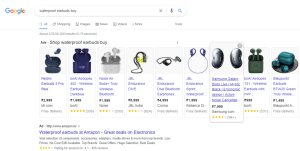Google and It’s Algorithm
In Google shopping, its algorithm for products happens to be an entirely different story. As long as you follow the rules, aka guidelines and specifications, you’re in the game and you will show up in the search results.
For your product, one of the most important things Google pays close attention to is the product title. It is the first thing a consumer sees after running a search for a product. Hence, Google will prefer these titles to be heavily optimized. You do that and your product moves up in the rank on the search result page. How do you benefit? Such highly optimized titles result in an increased click-through rate and sales growth!
Since last year, the hype around the Google algorithm has increased like a wildfire among the marketplaces of all sizes, including the biggies. They all rely on it to drive conversion. They understand that Google has an edge over competing marketplaces. This is due to the two prime factors: First, Google is an influential term. Worldwide, it is used 2 trillion times to perform a search per year, among which Google Shopping accounts for a substantial portion. Compared to other shopping platforms like Amazon or eBay, the search on Google shopping is twice as high. Second, Google acts as a shelter for most brands. Many customers consider Google a trusted source for authentic product information. Consequently, if you are found on Google, a customer tends to trust you more.
Today, you’ll learn how to create a perfect product title that is completely in sync with the consumer’s search.
Guidelines
Image Credits : Google
In the above image, the search results are nearly identical to what a user typed in. Observe and note that the keywords “waterproof” and “earbuds” are the main characters in a search. Credit goes to the title. It describes the product in mere 5-6 words and is easy to comprehend, hence, favored by search engines. So, let’s run through the best practices for a perfect product title on Google Shopping.
Use Relevant Keywords
Would the result have been the same if you had mentioned “earphones” rather than “earbuds?” Certainly not. These minute details matter heavily, as they can change the entire category of the product. And the same would have been reflected in the search results, bringing the product with the others that are relevant to that category.
A keyword is a great way to cover your customer/audience base. Once you understand which keywords customers prefer and which ones are trending, you can optimize your title accordingly. Creating the title of the product becomes effortless.
150 Characters in a Nutshell
If you are a Smart Seller, you would use all the 150 characters wisely to form an appealing product title. The main purpose of that title would have been including every element of a product, right from a brand name to quantity. Google is very particular about such details and can even truncate the extra or fluff content. Many times, if a title doesn’t fit within 150 characters, Google trims it accordingly. Thus, Google advises its sellers to write relevant titles.
Follow the formula
“Nike Pro Short Sleeve Training Top”
Brand + Product + Attribute 1 + Attribute 2 + Quantity (optional)
Although there’s no sure-shot formula to help you build a perfect product title, there’s one that can bring you close to creating one. The formula is made according to what a customer would usually search for. It accompanies all the elements of a product, whether it is a “short sleeve” or “training top.”
An optimized product title is very hard to find. Take a look at this and answer which title you find informative.
Type 1: Colored Trim Tee
Type 2: Dolce & Gabbana Color Printed Trim Tee Women’s Short-Sleeve Pack of 3
If you selected Type 2, good news – you got into the good books of Google.
Specifications
Here’s a quick list of do’s and don’ts that you can keep handy so that your title stays within the radar of Google algorithms. Don’t forget to pin them up.
- Pay attention to these attributes and mention them in the title when necessary. In the end, these attributes will become the search parameter of your product –
Model Name – “ABC X27 Pro”
Color – “Green”
Size – “XL”
Gender – “M/F” - Your product title should be the same as per the product body mentioned on the landing page
- Be grammatically correct, a user doesn’t make grammatical errors while searching for a product, you too shouldn’t
- Capitalization is used only when you are mentioning countries, currencies, or brand names not to emphasize on product attributes, avoid capitalization of titles at all cost
- Except for the brand that already has foreign words in it, avoid using foreign vocabulary as that is difficult for people to understand
- You should never pad your titles with promotion texts such as “best offer” or “best seller on Amazon”
- Extra spaces scavenge the opportunity to craft a perfectly efficient title, therefore avoid using extra space
- As emojis showcase gimmick and are generally found in the arsenal of spammers, you should totally avoid using them, the same goes for symbols and special characters such as “! @,#,$”
Take Note :
For you, titles are the backbone of your entire product listing. Despite all the dos and don’ts, creating titles can be complicated. Even if you create one, how sure are you whether it is truly optimized? What tool will you use to track its success? How will you calculate the CTR? Who will track the user? Wouldn’t it be easier for you to measure the performance of your listing once you get those answers? But you need to focus on your business expansion, extending the breadth of your product category, or strategize the next marketing move. In such a state, you need someone who knows the trick of the trade. And that is where we step in.
Our expertise in creating a product listing comes with all the shebang from title optimization to attribute mapping. Get in touch with us and see your listing thrive on Google Shopping.





